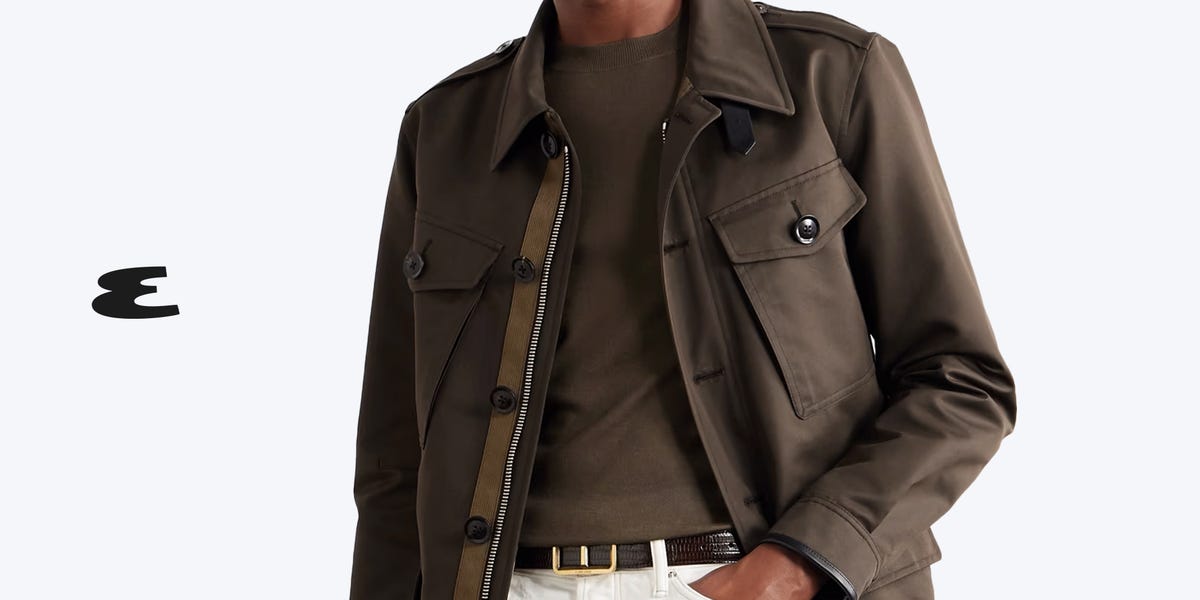Listen, the chore coat isn’t going anywhere. The classic silhouette dates back to 19th-century France, and it’ll take more than a decade of street-style coverage and Pinterest mood boards to bench it. There are great chore coats out there that you can and should buy. Octobre Éditions has a modern French reinterpretation of one. I took this Vintage Heavy Trout embroidered one on a recent fly-fishing trip. My Esquire editors stand by Le Mont St. Michel. And as a Michigander, I’m partial to a Carhartt.
But I’m here to suggest a chore-coat alternative for your jacket rotation, something with a more modern fit, ready for late-season layering. I’m suggesting the station jacket. A humble, American invention, inspired by a combination of military and work-wear origins—aka, a hybrid of menswear’s best roots.
Service vs. Station Jacket
You can sometimes find it under the name of “service jacket,” like this burly and affordable Dickies Utility Service Jacket. You’ll commonly find station jackets with two button-closed chest pockets and service jackets with one or two zipper chest pockets, but there’s not a well-defined formula for what makes a station jacket. Imogene + Willie, which specializes in Americana, doesn’t force the distinction, calling its version the “service station” jacket. Cult N.Y.C. work-wear brand Randy’s Garments has both: a station jacket with button pockets and a service jacket with zips.
For the purpose of this article, let’s conflate the two. Purists can feel free to argue with me in the comments, but this is more akin to the difference between bourbon and Tennessee whiskey than between Scotch whisky and Irish whiskey. No governing bodies are fighting for possession of a rogue e here. We’re just having fun getting dressed.
Military Influence, Work-Wear Roots
Like khakis, desert boots, and the wristwatch, the station jacket is influenced by military history. If you look at these options, you’ll see a lot of Eisenhower’s famed Ike jacket. During WWII, General Eisenhower wanted a jacket modeled off the British battle-dress jackets—unlined, cropped to the waist, with big scalloped flap pockets. After the war, that military shape stuck around when Dickies added a zipper, kept the future president’s name, and carried the shape into the American work-wear consciousness for station attendants and other laborers. From there, the thread unravels, and you start to get synthetic-fiber work jackets like the one James Dean wears in Rebel Without a Cause.
The modern-day station jacket is an amalgamation of all that. Generally speaking, it has a zip front with a cropped cut and at least two pockets, be they warmer or chest pockets, but it retains the front pockets and cropped fit of the general-turned-president’s namesake (one that he was literally buried in). While the jacket’s etymology might be in question, its functionality isn’t. The best versions lean into the simple design, clean zipper (buttons accepted case by case), rugged fabric, and that cropped fit.
Dickies is still the standard-bearer with the Utility Service and (of course) the Eisenhower. Patagonia had a great option made from an undyed, natural, organic cotton that’ll hopefully come back to the catalog. Levi’s keeps the original military references with a button-up Embarcadero Station Jacket. Doing it in denim blurs us into trucker territory, but that shape and lack of pleating keep it from looking like any type 1, 2, or 3 jackets. Levi’s also makes a Carhartt Detroit competitor, the “Mechanics Jacket.” Classic leather brand Schott leans into heritage with its Wool Plaid Station Jacket. Maybe the best interpretations come from menswear’s best reinterpreter. Todd Snyder has a version in a summery linen/cotton/silk blend and a sumptuous linen/cotton/cashmere blend. Gotta know the rules before you can break them.
This past winter I put a lot of miles on Outerknown’s Station Jacket. While the fit is a little bit California cool guy, boxier and more oversize than the typical cropped take, it lives up to the station-jacket name. Bonus points that it’s woven from 100 percent recycled wool and has a similar look to the N007 piece Carmy wore on The Bear.
Buck Mason has made a linen version that’s become my go-to warm-weather take on the style. On a recent trip to Miami, a version of it was the ideal combo of functional and dressy, hiding my vintage soccer jersey at the Michelin-acknowledged Doya and making me feel a little more at home. It’s unfortunately no longer in the line, but the new Natural Breakwater Sportster scratches a similar itch, leaning more toward that water-repellant James Dean take.
The Silhouette Matters Most
We’ve spent a lot of this story splitting fashion hairs, so it’s no surprise that sometimes you have to get creative with these search terms. Industry of All Nations calls its offering a sports jacket, but it’s not fooling me. Percival hides its station jacket under the nom de plume of Check Anderson Wool Fleece, but it fits the bill. A Carhartt Detroit and Ayr’s Scrambler make the cut, though both take some bomber cues. Or, if you’re a freak about materials and dyeing, San Fransisco legend Evan Kinori makes two styles of zip jacket (one and two) that are undoubtedly station-y. Though these are a lot boxier than others, the cropped fit is there, and the fascinating fabrics and weird organic dyeing processes are always worth a shout. Then, to come full circle, the Paris-based Brut archives reissued a station jacket that’s long sold out, but I’m on the eBay prowl for one. Let’s get into a bidding war together.
Regardless of which jacket you choose or what a brand calls the damn thing, reach for one instead of a chore coat. The crop makes layering fun, and the ruggedness stands up to the rigors of modern life. I believe the station-jacket economy is on a tear, ready to break the chore coat’s menswear chokehold. Just give it another century.
Read the full article here

.jpg)



















